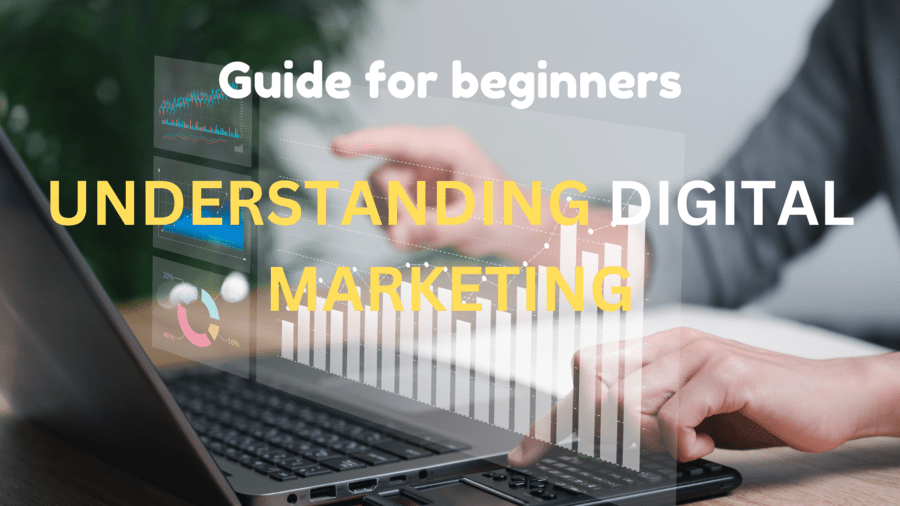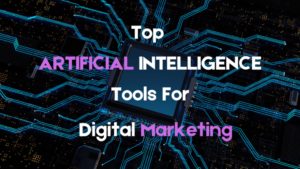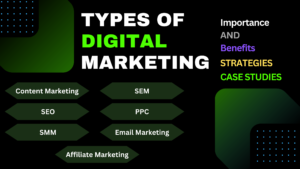Understanding Digital Marketing: A Guide for Beginners teaches the fundamentals of digital marketing, including SEO, SEM, PPC, social media marketing (SMM), content marketing, and email marketing strategies, and their types like blog, strategy, KPI, benefits, and importance.
Learn to connect with your audience effectively and enhance brand visibility in the digital age.
Introduction to Digital Marketing
Digital marketing promotes products and services using electronic platforms like websites, email, social media, and search engines. It deploys online marketing tactics to establish customer relationships, improve brand awareness, and upsell. Unlike traditional promotion techniques, Internet-based advertising provides instant performance and ROI tracking tools.
Difference Between Digital Marketing and Traditional Marketing
Both digital and traditional marketing are integral components of marketing strategies, with digital focusing on online channels and traditional encompassing offline methods. Their goals are to reach and engage audiences and effectively promote products or services.
Traditional Marketing
Traditional marketing channels are usually expensive, and it is hard to evaluate their return on investment (ROI) because they include print, radio, TV, billboards, and direct mail to reach audiences.
Digital Marketing
Optimizing online channels such as search engines, social media, email, websites, and mobile apps to connect with customers. Digital marketing channels are used by e-commerce marketers instead because they are more flexible, traceable, and cheaper.
E-commerce
The process in which products and services are bought or sold electronically over the Internet, is a key area where digital marketing strategies are applied. It provides customers with multiple ways to boost their sales through online marketing strategies.
Importance and Relevance in Today’s Digital Marketing
In today’s digital age, everyone is online, including businesses that need digital marketing for global reach. Digital marketing provides many benefits compared to traditional methods, including cost-effectiveness and the ability to send marketing messages to customers regardless of physical location.
Digital marketing is often called “perfect precision targeting” because it ensures you only direct your marketing to those you want to hear from. This not only saves you funds that may have been spent on advertising that does not target the right people but also leads to better customer satisfaction.
Core Components of Digital Marketing
Here are six main basic components of digital marketing in this guide are given below
Search Engine Optimization (SEO)
The main focus of search engine optimization (SEO) is increasing a website’s visibility in search engine results pages (SERPs) and making the website friendly to search engines and online visibility/presence. Implementing a profitable SEO strategy requires a deep understanding of keyword research. Keywords are essential in ranking in the top search engine page results.
There are few key factors of search engine optimization (SEO) are given below;
On-Page Optimization
Optimizing content, HTML, and keyword usage to improve the rankings and draw more relevant traffic from search engines for individual web pages.
Off-Page Optimization
Enhancing a website’s authority and ranking by building high-quality backlinks and promoting content externally.
Technical SEO
Ensuring a website meets the technical requirements of search engines for crawling, indexing, and ranking, such as site speed, mobile-friendliness, and secure connections.
Search Engine Marketing (SEM)
Search engine marketing (SEM) is an advertising strategy involving paid strategies to increase visibility on search engines. Such methods include display ads, remarketing, and PPC advertising. Consequently, companies can place ads before individuals looking for related products or services, thus making it the most specific and high-ranking marketing approach.
Pay-Per-Click (PPC) Advertising
PPC is a part of (SEM), Purchasing ad placements on search engines like Google and Yahoo and on social media platforms such as Facebook, Twitter, and Instagram constitutes PPC advertising, also known as PPV advertising. This payment model involves paying a certain amount every time someone clicks on your ad link displayed in search engine result pages (SERPs) or on social networking sites like Facebook retargeting programmatic display ad banner campaign optimization services. The charges only apply to genuine visitors to your site. It is cost-effective and easy to start running a pay-per-click ad campaign, and it doesn’t take long to adjust it if necessary.
Social Media Marketing
Advertising products or services by engaging on social media platforms like Facebook, Instagram, Twitter, and LinkedIn is a common strategy. We are focused on creating compelling content that engages users and builds the business name. Advertising allows direct customer interaction, provides valuable feedback, and enhances customer relationships.
Content Marketing
Content marketing is Attracting and keeping a specific audience by producing and sharing useful and pertinent material. This includes blog posts, articles, videos, infographics, podcasts, and more. The goal is to provide informative and helpful and address the audience’s needs and pain points with the content, establishing the brand as an authority in the industry and building trust.
Email Marketing
They promote products or services, share news, or build relationships by sending targeted emails to a specific audience or subscriber list. Effective email marketing campaigns can lead to high engagement rates and conversions. They include segmenting the email list, personalizing messages, and using automation tools to send timely and relevant emails.
About Understanding Digital Marketing: A Guide for Beginners
Provides a comprehensive overview of key strategies, tools, future trends, examples, case studies, emerging trends, and KPIs in digital marketing, ‘Understanding Digital Marketing: A Guide for Beginners’ delves into various aspects such as content creation, social media engagement, SEO optimization, email marketing, and more. Whether exploring innovative strategies or analyzing real-world applications, this resource equips beginners with the knowledge to navigate and excel in the dynamic digital marketing landscape.
Digital Marketing Strategies
In this Guide “Understanding Digital Marketing” Here we have discussed below digital marketing tactics or techniques for beginners
Setting Goals and Objectives
Successful online marketing starts by establishing well-defined, measurable goals and objectives. These goals should align with your business objectives and guide your marketing efforts. For instance, if you need more people visiting your site, you could generate more leads through online advertising, increasing sales. Consequently, you can buy more products after being recommended by friends who were already there and loved them.
Identifying Target Audience
Understanding your target audience and what they want is essential for creating relevant and effective marketing campaigns. This involves market research to identify demographics, psychographics, and behavioral traits. Understanding your audience makes tailoring your messaging and choosing the channels to reach them possible.
Creating a Digital Marketing Plan
A digital marketing plan outlines your strategies and tactics to achieve your marketing goals. It includes defining your value proposition, selecting the appropriate digital channels, creating a content calendar, and setting a budget. A well-structured plan ensures all efforts are coordinated and focused on achieving the desired outcomes.
Measuring and Analyzing Digital Marketing Performance
Key Performance Indicators (KPIs)
Measuring the effectiveness of your digital marketing efforts involves using specific metrics known as KPIs. These metrics include website traffic, conversion, click-through, engagement, and return on investment (ROI). Tracking and identifying these KPIs is crucial for assessing the success of your strategies and pinpointing areas for improvement.
Tracking and Reporting Metrics
Tracking and reporting metrics regularly offers valuable insights into the performance of your digital marketing campaigns. Tools like Google Analytics, SEMrush, and social media analytics platforms help gather and analyze data. Reporting metrics allow you to measure progress, identify trends, and make data-driven decisions.
Making Data-Driven Decisions
Using data to inform your marketing decisions ensures that your strategies are evidence-based and more likely to succeed. Examining data allows you to pinpoint effective and ineffective strategies, enabling you to enhance your campaigns for improved outcomes. Data-driven decisions lead to more efficient resource use and improved marketing performance.
Tools and Technologies in Digital Marketing
Here are many tools for digital marketing both paid and free tools (with limited resources), but here we discussed about important tools for digital marketing which helps to understand digital marketing for beginners
Analytics Tools (Google Analytics, SEMrush, etc.)
Analytics tools help measure and analyze the performance of your digital marketing campaigns. They provide insights into website traffic, user behavior, and conversion rates. Google Analytics and SEMrush provide in-depth reports and visual data representations, allowing you to make well-informed choices and enhance your strategies.
Email Marketing Software (MailChimp, Constant Contact)
You can create, send, and track email campaigns effectively using email marketing software. These tools offer features like email templates, list segmentation, automation, A/B testing, and analytics. MailChimp and Constant Contact are popular options that help streamline email marketing efforts and improve engagement rates.
Social Media Management Tools (Hootsuite, Buffer)
These tools make managing and organizing social media posts, monitoring engagement, and evaluating performance easier. Hootsuite and Buffer enable you to schedule and streamline your social media content, keep track of mentions and messages, and produce analytics. They simplify the process and guarantee a steady and impactful social media presence.
SEO Tools (Ahrefs, Moz)
SEO tools assist in keyword research, site audits, and tracking the performance of SEO efforts. Ahrefs and Moz provide comprehensive features to analyze backlinks, monitor rankings, and identify SEO opportunities. Using these tools helps improve search engine visibility and organic traffic.
Content Management Systems (WordPress, Squarespace)
CMS platforms help create, manage, and publish digital content easily. WordPress and Squarespace offer user-friendly interfaces, customizable templates, and plugins/extensions to enhance functionality. They enable businesses to build and maintain professional websites without extensive technical knowledge.
Future Trends in Digital Marketing
Discussed below about future trends of digital marketing according to this guide “Understanding Digital Marketing”
Voice Search Optimization
With the rise of voice-activated assistants like Siri, Alexa, and Google Assistant, voice search optimization is becoming increasingly important. Voice search optimization involves tailoring your content to match conversational queries and using structured data to enhance search engine understanding. This trend is expected to grow as more users adopt voice search technology.
Artificial Intelligence in Marketing
AI analyzes consumer data, personalized marketing efforts and automates tasks. AI-powered tools can predict customer behavior, recommend products, and optimize ad targeting. AI in marketing strategies can enhance efficiency, improve customer experiences, and drive better results.
Influencer Marketing
Leveraging influencers to promote products can enhance brand credibility and reach a wider audience. Influencer marketing involves partnering with individuals who have a significant following on social media or other platforms. These influencers can create authentic content and endorsements that resonate with their audience, driving brand awareness and engagement.
Case Studies and Examples
Successful Digital Marketing Campaigns
Analyzing successful campaigns provides insights into practical strategies and tactics. Case studies of brands like Coca-Cola, Nike, and Apple showcase innovative approaches to digital marketing. These examples highlight the importance of creativity, audience understanding, and strategic planning in achieving marketing success.
Lessons Learned from Failed Campaigns
Understanding why campaigns fail can help avoid similar mistakes and improve future efforts. Case studies of failed campaigns provide valuable lessons on what not to do. Common reasons for failure include poor audience targeting, lack of clear goals, inadequate budget, and ineffective messaging. Learning from these failures helps refine strategies and enhance future performance.Understanding Digital Marketing guide helps you to finding the solutions.
Future of Digital Marketing
There we have discussed about som future trend in this guide “Understanding Digital Marketing” are given below
Emerging Trends (AI, VR, Voice Search)
Future trends in digital marketing include the growing use of AI, virtual reality (VR), and voice search technologies. AI will continue to revolutionize marketing with advanced data analytics and automation. VR offers immersive experiences that can enhance customer engagement. Voice search optimization will become crucial as more users rely on voice-activated devices.
Predictions for the Next 5-10 Years
Experts predict that digital marketing will continue to evolve, with increasing emphasis on personalization, automation, and immersive experiences. Businesses must adapt to changing technologies and consumer behaviors to stay competitive. The integration of AI, VR, and voice search will play a significant role in shaping the future of digital marketing.
Conclusion
Recap of Key Points
Understanding Digital Marketing: A Guide for Beginners emphasizes that digital marketing is essential in today’s market, providing numerous channels and strategies to connect with customers and grow businesses. Core components include SEO, SEM, PPC, social media, content, and email marketing. Effective strategies involve setting goals, identifying target audiences, and using the right tools and technologies. This comprehensive guide ensures you grasp the essentials of digital marketing, including types like blog, strategy, KPI, benefits, and importance, equipping you to effectively enhance brand visibility and engage with your audience in the digital age.
Final Tips for Beginners
Start with clear goals, know your audience, and continuously measure and adjust your strategies. Focus on creating valuable content, leveraging data, and staying updated with the latest trends. Experiment with different tactics and learn from successes and failures to refine your approach.
Resources for Further Learning
Explore online courses, blogs, and books to deepen your understanding of digital marketing and stay updated with the latest trends—websites like HubSpot, Moz, and Neil Patel’s blog offer valuable resources. Online learning platforms like Coursera and Udemy provide courses on various digital marketing topics.




